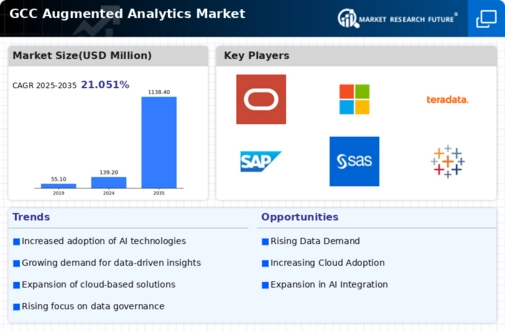The GCC Augmented Analytics Market is experiencing a dynamic evolution driven by advancements in artificial intelligence, machine learning, and data processing technologies. Organizations across the Gulf Cooperation Council are increasingly leveraging these technologies to enhance their data analysis capabilities and drive informed decision-making processes. In this competitive landscape, several key players are significantly impacting the market, each deploying distinctive strategies and solutions tailored to meet the specific needs of various industries. The rise in data-driven decision-making has prompted businesses to focus on implementing augmented analytics solutions, which combine conventional data analytics with advanced AI tools to automate insights generation.
As companies seek to harness insights from vast amounts of data, the competition among providers intensifies, characterized by innovation, strategic partnerships, and a commitment to customer-centric models.Oracle has established a robust presence in the GCC Augmented Analytics Market by offering a comprehensive suite of analytics solutions that enable organizations to gain deep insights into their data. Known for its strong technical foundation and advanced capabilities, Oracle provides tools that empower users to access, analyze, and visualize data effectively. The company’s strengths in the region stem from its well-recognized portfolio that combines database management with advanced analytics features.
Furthermore, Oracle emphasizes security and compliance, a critical factor for enterprises operating in the GCC, which enhances its attractiveness. The ability to adapt its offerings to suit various local industries, including finance, healthcare, and retail, further solidifies Oracle's competitive standing in the market.Microsoft is another significant player within the GCC Augmented Analytics Market, recognized for its innovative product lineup, particularly its Power BI platform, which brings together business intelligence, data analytics, and interactive visualizations.
Microsoft's strong market presence in the region is supported by its cloud services, integration capabilities, and user-friendly interface, making advanced analytics accessible to a broader user base.
The company leverages its global infrastructure to ensure data security and scalability, addressing key concerns for businesses in the GCC. Furthermore, Microsoft has successfully engaged in various strategic partnerships and acquisitions that enhance its capabilities and service offerings in augmented analytics. By positioning itself as a leader in providing comprehensive data solutions tailored to the regional market needs, Microsoft continues to maintain its competitive advantage, catering to diverse sectors, thus reinforcing its role in shaping the future of augmented analytics in the GCC.























